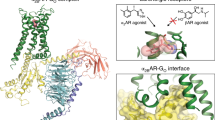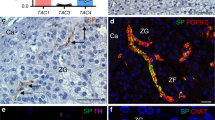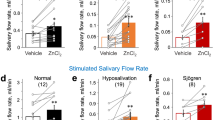Abstract
The regulation of central and peripheral adrenergic receptors by various chemical, physiological, pharmacological and pathological stimuli has been the subject of intense study1,2. For example, drug treatments can produce relatively small changes in the density of existing receptor binding sites in a variety of tissues. The α-adrenergic receptors in rat salivary gland tissue have been studied using radioligand receptor binding techniques3. We have recently identified and characterised α1-adrenergic receptors in the rat submandibular gland4, but surprisingly, α2-adrenergic receptor binding was not detectable. We now report that a single treatment of reserpine results in the appearance of α2-adrenergic binding sites within 12 h. Continued treatment with the drug produces further increases in the number of α2-adrenergic receptors, such that after 7 days the levels of α1- and α2-adrenergic receptors are similar. This is the first example of a drug treatment resulting in the appearance of a receptor type which was not previously detectable.
This is a preview of subscription content, access via your institution
Access options
Subscribe to this journal
Receive 51 print issues and online access
$199.00 per year
only $3.90 per issue
Buy this article
- Purchase on Springer Link
- Instant access to full article PDF
Prices may be subject to local taxes which are calculated during checkout
Similar content being viewed by others
References
Williams, L. T. & Lefkowitz, R. J. Receptor Binding Studies in Adrenergic Pharmacology, 127–149 (Raven, New York, 1978).
Bylund, D. B. in Modulators, Mediators and Specifiers of Brain Function (eds Ehrlich, Y. H. et al.) 133–162 (Plenum, New York, 1979).
Strittmatter, W. J., Davis, J. N. & Lefkowitz, R. J. J. biol. Chem. 252, 5472–5477; 5478–5482 (1977).
Bylund, D. B. & Martinez, J. R. Physiologist 22, 16 (1979).
Langer, S. Z. Br. J. Pharmac. 60, 481–487 (1977).
U'Prichard, D. C., Greenberg, D. A. & Snyder, S. H. Molec. Pharmac. 13, 454–473 (1977).
U'Prichard, D. C. & Snyder, S. H. Life Sci. 24, 79–88 (1979).
Rosenthal, H. E. Analyt. Biochem. 20, 525–532 (1967).
Benmiloud, M. & Von Euler, U. S. Acta physiol. scand. 59, 34–42 (1963).
Martinez, J. R., Adelstein, E., Quissell, D. & Barbero, G. J. Pediat. Res. 9, 463–469 (1975).
Martinez, J. R., Adshead, P. C., Quissell, D. & Barbero, G. J. Pediat. Res. 9, 470–475 (1975).
di Sant'Agnese, P. A. & Davis, P. B. New Engl. J. Med. 295, 597–602 (1976).
Scatchard, G., Ann. N. Y. Acad. Sci. 51 660–672 (1949).
Author information
Authors and Affiliations
Rights and permissions
About this article
Cite this article
Bylund, D., Martinez, J. α2-Adrenergic receptors appear in rat salivary glands after reserpine treatment. Nature 285, 229–230 (1980). https://doi.org/10.1038/285229a0
Received:
Accepted:
Issue Date:
DOI: https://doi.org/10.1038/285229a0
This article is cited by
-
Brain α2‐adrenoceptors in monoamine‐depleted rats: increased receptor density, G coupling proteins, receptor turnover and receptor mRNA
British Journal of Pharmacology (2001)
-
Enhanced α2A‐autoreceptor reserve for clonidine induced by reserpine and cholinomimetic agents in the rat vas deferens
British Journal of Pharmacology (1997)
-
Characterization of autonomic receptors in the rat sublingual gland by biochemical and radioligand assays
Naunyn-Schmiedeberg's Archives of Pharmacology (1982)
Comments
By submitting a comment you agree to abide by our Terms and Community Guidelines. If you find something abusive or that does not comply with our terms or guidelines please flag it as inappropriate.



